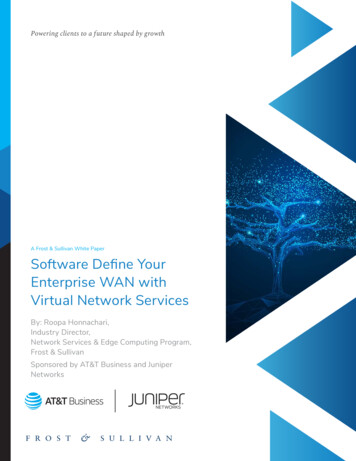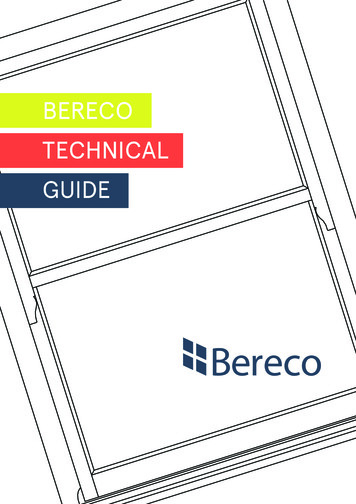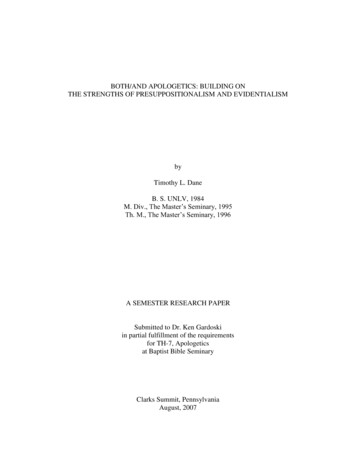
Transcription
Powering clients to a future shaped by growthA Frost & Sullivan White PaperSoftware Define YourEnterprise WAN withVirtual Network ServicesBy: Roopa Honnachari,Industry Director,Network Services & Edge Computing Program,Frost & SullivanSponsored by AT&T Business and JuniperNetworks
Contents3 Introduction4Why Should Enterprises Care AboutNFV‑based Services?7Market Trends Driving the Need for VirtualNetwork Services9AT&T FlexWareSM11Conclusion11About Juniper NetworksAll rights reserved 2021 Frost & Sullivan www.frost.com
Software Define Your Enterprise WAN with Virtual Network ServicesIntroductionAs businesses across verticals embrace hybrid cloud, Internet of Things (IoT), remote working,and edge computing trends, it is imperative to ensure the wide area network (WAN) being usedis agile, flexible, and highly secure. Although software-defined WAN (SD-WAN) solutions inthe market today come integrated with some of these network functions—routing and securityfunctions, for example—the network function virtualization (NFV)-based approach uses virtualuniversal customer premises equipment (uCPE) that can host multiple virtual network functions(VNF). When an organization deploys SD-WAN, it is critical to closely evaluate all other importantnetwork functions to ensure a cohesive WAN. Deploying a uCPE platform that can host multipleVNFs, including SD-WAN, addresses WAN virtualization holistically while giving networkadministrators the freedom to pick and choose vendor solutions.NFV-based virtual network services have been available in the market since 2016, but theyhave experienced slow market adoption due to several factors: cost of the uCPE, complexitiesinvolved in service chaining and orchestrating multiple VNFs across multiple domains, and lackof clear understanding among network decision-makers on the true value of a uCPE approach,to list a few. However, virtual network services have evolved greatly in the last couple of yearsto address those challenges and offer several benefits not possible from previous offerings. Inthis paper, we summarize the greater benefits of virtual network services when compared toa traditional hardware approach, look at market trends driving the need for a platform-centricarchitecture to WAN virtualization, and offer insight into AT&T’s virtual network servicesportfolio—AT&T FlexWare.When an organizationdeploys SD-WAN, it iscritical to closely evaluateall other important networkfunctions to ensure acohesive WAN.All rights reserved 2021 Frost & Sullivan www.frost.com3
4Software Define Your Enterprise WAN with Virtual Network ServicesWhy Should Enterprises Care AboutNFV‑based Services?The enterprise WAN consists of multiple proprietary hardware devices—routers, WANoptimization controller (WOC), application delivery controller (ADC), firewalls, applicationvisibility—that are expensive to deploy and manage. In contrast, NFV uses virtualizationtechniques to deploy network functions in software—virtual network function (VNF)—runningon commodity hardware. Using VNFs, enterprises can achieve enhanced control over theirnetworking functions, with dramatically improved provisioning cycle times, and deploy newapplications and services in a matter of hours or days. The following list describes traditionalnetwork challenges addressed by adopting VNFs. Exhibit 1 compares a traditional networkapproach against an NFV approach.Network Function Virtualization ExplainedExhibit 1: Traditional Approach vs. NFV ApproachTraditional Network Appliance ApproachNetwork Function Virtualization ApproachEdge RouterVirtualNetworkFunctionsFirewallVirtual AppliancesWANAcceleratorPremisesWirelessLAN .Orchestrated, automatic, remote installation of VNFStandardServersStandardStorageSpecialized, proprietary hardwareSoftware-based deploymentPhysical install per appliance per siteMultiple functions on common hardwareComplex network managementLess complexity, better performance, lower costSource: Frost & SullivanWith NFV, the enterprise WAN equipment is replaced by virtualized customer premisesequipment that can run multiple VNFs and is called universal CPE, or uCPE. The uCPE canbe installed in a telco closet or a data center. The uCPE is a plug-and-play device that can beeffortlessly set up by an enterprise IT team. The device, once plugged in and booted up, connectsto the network service provider (NSP) cloud, downloads the necessary VNFs, and installsand activates the software. For example, separate VNFs could be launched for each networkAll rights reserved 2021 Frost & Sullivan www.frost.com
Software Define Your Enterprise WAN with Virtual Network Services5function—one VNF for WAN optimization and onefor firewall—instead of deploying multiple hardwaredevices.VNFs can be instantiatedFaster Deployment Cycles withReduced Operational Costsprogrammed and managedIn the traditional network approach, every networkfunction runs on proprietary hardware appliancesthat are physically deployed and maintainedseparately. When all of the network functions thatenterprises have at each site are multiplied by thenumber of locations, it quickly adds up to hundreds orthousands of boxes to manage in the network. WithNFV, VNFs can be deployed on a premises‑basedx86 white box or in the cloud, thus reducing theamount of hardware equipment in the enterpriseWAN; which means reduced hardware costs, fewermoving parts, less chance for things to go wrong, andlimited maintenance for the IT team due to reducedoverall operational scale. Furthermore, VNFs canbe instantiated on-demand and programmed andmanaged remotely, leading to dramatically shorterdelivery cycles—as services can be deployed inminutes rather than days—than what is required bythe traditional hardware‑based approach.Improved WAN EfficiencyAs VNFs run on a virtualized uCPE, the number ofdevices that need physical maintenance is limited. Inthe traditional network approach, if a device fails, theNSP must replace the hardware for each function.In the case of VNFs, network administrators cansimply rip and rebuild that function, as it is deployedas software. The VNF download and storageconfiguration can be up and running in a matter ofminutes, as opposed to days in the hardware-centricapproach. Furthermore, NSPs offer service levelagreements that typically include the shipping of areplacement uCPE within 4 to 6 hours if the physicaldevice fails.Moreover, the software-centric nature of VNFsmakes it easy for network administrators to carry outon-going maintenance of WANs. In the traditionalnetwork approach, for any changes to the networkAll rights reserved 2021 Frost & Sullivan www.frost.comon-demand andremotely, leading todramatically shorterdelivery cycles—asservices can be deployedin minutes rather thandays—than what isrequired by the traditionalhardware‑based approach.
6Software Define Your Enterprise WAN with Virtual Network Servicesfunctions, a technician is deployed to physically carry out the reload on the equipment forenterprises. With VNFs, the NSP’s support team can remotely access the VNFs to make periodicchanges and updates. The cost savings, in terms of maintenance alone, could result in 10 to 15%savings for enterprises.Ability to Deploy Enhanced Security Features in a Modular FashionNFV-based solutions make it easier to deploy additional security measures, in near real-time,because everything is in the virtual machines (VMs). Enterprise IT departments can choose todeploy modular security solutions by spinning up VMs to combine solutions from multiple vendors.For example, users can deploy a virtual firewall from one vendor and then add a set of additionalfeatures from other vendors. In the event of a distributed denial of service (DDoS) attack on theVM or a VNF, the affected VM can be quickly detected, isolated, shut down, quarantined, andreplaced by another dynamically instantiated VM. The threat can then be quickly resolved byapplying security patches to fix the code vulnerability. Enterprise IT teams can quickly spin‑upidentical VMs in a different location to restore and protect the resiliency and reliability ofinfrastructure. In addition, the VNF approach reduces network administration and managementburdens for the IT teams as it is a lot easier to deal with VMs compared to physical appliancesor hardware. For example, software policies can be set up for patching updates to happen atscheduled times.Catalog-based Multi-vendor Approach Offers Superior Vendor ChoicesWith NFV, NSPs can aggregate multiple vendors’ solutions and provide enterprises the abilityto choose VNFs from various vendors. Enterprises can choose from a catalog of VNFs, whichsimplifies vendor management by eliminating the hassle of dealing with multiple vendorsfor each network function. The NSP takes on the responsibility of vetting and certifying thesolution vendor and managing relationships with it for the end customer. The catalog-basedmulti‑vendor approach enables enterprise IT teams to innovate faster because they can nowchoose best‑of‑breed solutions from different vendors without investing in the capital expenditure(CAPEX) required from the traditional approach. For example, if they want to use a JuniperNetworks router instead of Cisco, they can do so; it is only a matter of downloading the softwareand configuring it. Alternatively, if they have always used Cisco but want to try a product from astart-up, they can do so using the VNF approach.The catalog-based multi‑vendor approach enablesenterprise IT teams to innovate faster because they cannow choose best‑of‑breed solutions from different vendorswithout investing in the capital expenditure (CAPEX)required from the traditional approach.– Frost & SullivanAll rights reserved 2021 Frost & Sullivan www.frost.com
Software Define Your Enterprise WAN with Virtual Network ServicesFulfills “Green” Requirements by Reducing Hardware SprawlThe uCPE typically has a thin profile and is racked, which eliminates the need for separatehardware for each function and enables multiple VNFs to be delivered using a single device. Froman environmental perspective and cost consideration it uses less power, so enterprises can adhereto any “green” initiatives they have in place. The uCPE also eliminates hardware sprawl, and hencereduces organizations’ carbon footprint as well as the power and cooling expenses needed fortelecom closets and data centers.Market Trends Driving the Need for VirtualNetwork ServicesBusinesses Ramp-up Digital Strategy EffortsThe COVID-19 pandemic has forced many businesses to fast-track their digital strategy. Asorganizations emerge from the pandemic, they are increasingly looking to deploy technologiesto optimize resources, increase operational efficiency, and enhance business continuity. Frost &Sullivan research shows that hybrid cloud, unified communication as a service (UCaaS), SD‑WAN,and network and application security are some of the areas in which businesses continue toinvest. Virtual network services can dramatically reduce a business’s hardware costs as multiplenetwork functions can be consolidated into a single virtual uCPE. Furthermore, the softwarecentric approach enables VNFs to be instantiated effortlessly at the branch, datacenter, or cloudlocation, making it easy to deploy and manage network functions on the go.Rise in SD-WAN AdoptionIn a recent Frost & Sullivan SD-WAN survey, 27% of the respondents indicate they have deployedor have a SD-WAN deployment underway, and another 15% indicate they are extendingSD‑WAN to additional locations. Cost-effective branch site connectivity, fast deployment times,centralized network management, and optimized cloud connectivity are some of the drivers formanaged SD-WAN adoption among businesses. Frost & Sullivan estimates North Americanmarket revenues exceeded 2 billion in 2020, with more than 200,000 operational sites. AsSD-WAN adoption gains traction, businesses understand that to fully realize the potential of asoftware-centric architecture, several WAN functions must be agile. Routing, WAN optimization,security, and session border controllers are some of the functions that the uCPE model helpsbusinesses consolidate and orchestrate from a single appliance. Therefore, although the SD‑WANappliance offers some in-built routing, security, and WAN opt features, it is prudent thatbusinesses select the uCPE model that supports multiple VNFs and offers the flexibility to choosefrom a catalog of vendors when architecting WANs.All rights reserved 2021 Frost & Sullivan www.frost.com7
Software Define Your Enterprise WAN with Virtual Network ServicesHybrid Cloud NetworkingIn Frost & Sullivan’s 2020 Global Cloud Survey, 52% of the respondents say they have deployedcloud infrastructure as a service (IaaS), and 42% currently use hybrid cloud. Moreover, 43% ofthe respondents indicate they plan to deploy hybrid cloud in the next two years. As enterpriseapplications get distributed across hybrid IT architecture, SD-WAN enables enterprise IT teamsto predefine business policies through the SD-WAN controller and to specify which cloudapplications are suitably accessed directly through the Internet versus backhauled to a hub site.So far, SD-WAN solutions have predominantly been deployed at the branch sites and cloud datacenters. For businesses’ hybrid cloud strategies to be successful, network managers need toensure on-premises data centers, colocation data centers, cloud POPs, and edge compute notesall support the same infrastructure as supported at a branch site. Ultimately, a uCPE offers theagility and flexibility to deploy VNFs at all of these connection points.Multi-vendor Approach Provides Wider ChoiceCustomers of traditional hardware-centric WAN have struggled with its lack of agility andflexibility, which has created strong vendor lock-in. Virtual network services shift the entirearchitecture to become software-centric, where network functions deploy in a virtual format. Thesoftware-centric architecture not only brings great agility for VNF deployment, but also bringsimmense flexibility and choice for businesses during vendor selection. The NFV-based approachoffers network functions on-demand through a catalog of best-of-breed solutions from multiplevendors. This means businesses have vendor independence to an extent (considering the catalogis still limited to the VNFs supported by the service provider), allowing customers to conducttechnology bake-offs before deciding on the vendor to use. For example, users can conducttrials with Cisco and Juniper Networks routing functions before choosing one. The traditionalhardware-based WAN edge design does not support this kind of flexibility in vendor selection ordeployment speed when designing or redesigning the WAN.All rights reserved 2021 Frost & Sullivan www.frost.com8
9Software Define Your Enterprise WAN with Virtual Network ServicesEnhance Global Competitiveness through Fast DeploymentAs organizations look to expand globally and bring new local sites online quickly, understandingwhich global regions make business sense is not always evident without testing the markets.With virtual network services, businesses have a cost-effective way to test new markets beforeinvesting CAPEX in branch locations. In fact, the COVID-19 pandemic aptly highlights thelimitations of hardware-centric branch architectures, and as most of the workforce (whereverapplicable) had to transition to a remote working environment, almost overnight, the challengesof shipping, deploying, configuring, and managing physical network appliances escalated. Asbusinesses adopt long-term remote working trends, a local presence is needed to optimize andsecure user connectivity to cloud-based applications. Businesses can deploy virtual networkservices at third-party data centers (e.g., Equinix) to establish themselves in local markets neartheir users and enable seamless access to cloud-based applications. Whereas traditional branchsite expansion involves a tedious and time-consuming process that limits businesses’ abilityto compete effectively, a virtualized WAN (using uCPE platform) approach creates a fast andefficient way for competitors to establish a global presence.Businesses can deploy virtual network services atthird‑party data centers to establish themselves in localmarkets near their users and enable seamless access tocloud-based applications.– Frost & SullivanAT&T FlexWareSMIn 2016, AT&T became the first service provider to launch commercial virtual network services—AT&T FlexWare—for the enterprise market. The AT&T FlexWare solution targets businessesof all sizes to help them procure VNFs, which can be dynamically instantiated on a commoninfrastructure when and where needed. AT&T FlexWare is part of the company’s overall softwaredefined solutions (SDS) portfolio, consisting of SD-WAN and software defined core to supportbandwidth on-demand services. The virtual network services are supported on AT&T FlexWareDevices that range from extra-small (supports 1 VNF) to extra-large (supports 12 VNFs)and cater to businesses’ various edge requirements. AT&T FlexWare is both transport- andcarrier‑agnostic, which means it supports a wide scope of transport options including MPLS,Internet, Ethernet, and TDM services.Extensive VNF Support across Multiple EnvironmentsAT&T FlexWare supports a broad range of certified VNF vendors across routing, WANoptimization, firewall, application visibility, and SD-WAN applications. Notable among the vendorssupplying VNFs include Juniper Networks, Cisco, VMware, Silver Peak, Fortinet, and Palo Alto.Some of these vendors offer multi-function VNFs, which when deployed on a uCPE are muchmore cost-competitive and easier to manage compared to single function VNFs. AT&T certifiedAll rights reserved 2021 Frost & Sullivan www.frost.com
10Software Define Your Enterprise WAN with Virtual Network ServicesVNFs can be deployed on-premises, in the public cloud (Microsoft Azure, Google Cloud Platform,and AWS), and in third-party data centers such as Equinix and TAO. The support for multienvironment VNFs is extremely critical for businesses to succeed in their hybrid cloud strategy,and AT&T FlexWare delivers that.Exhibit 2: AT&T FlexWare Multi-environment Deployment OptionsAT&T Network EdgeAT&T Global NetworkSD-WAN ic/Private cloudsSource: AT&TMulti-vendor OrchestrationAlthough virtual network services have been available since 2016, market adoption has beenslower than expected for several reasons. Key among them is the complexity of service chainingmultiple VNFs and orchestrating these VNFs across different devices, networks, and applications.To address this challenge, AT&T FlexWare is backed by a multi-domain orchestration platform(from Ericsson) that greatly simplifies service chaining and offers immense design flexibility interms of move, add, change, and delete requests.High-speed and High-availability Options across GeographiesAnother challenge to uCPE adoption has been the limitation of bandwidth speed options (mostsupported less than 1G speed) on these devices, which makes them unsuitable for data center andAll rights reserved 2021 Frost & Sullivan www.frost.com
Software Define Your Enterprise WAN with Virtual Network Serviceshub sites. Businesses gravitated to high-speed SD-WAN appliances instead to fulfill the need forhigh speed appliance at data centers and hub sites. AT&T FlexWare devices support up to 10Gspeeds to allow customers the ability to deploy uCPE devices across their WAN edge locations(on-premises, public cloud, private cloud and third-party data centers).As businesses adopt software-centric architecture, it is prudent that they consider resiliencyoptions to ensure continuity of operations. For instance, AT&T FlexWare is available in highavailability options of dual AT&T FlexWare devices and dual transport options. Customers canchoose from service chaining combinations for firewall SD-WAN and routing firewall, in anactive/passive model. Further, traffic can be set up to re-route over AT&T Network-Based IPRemote Access (ANIRA) or via customer-configured wireless routers.Service Availability & Pricing StructureAT&T FlexWare is available in more than 200 countries and territories. Pricing structure allowsfor subscription-based pricing for the AT&T FlexWare service, thus enabling businesses to movetoward an OPEX model.ConclusionThe traditional static, hardware-centric approach to building WAN architecture is complex andtime-consuming, which hinders enterprises digital transformation efforts. Although SD-WANtechnology offers some agility, it addresses only the automated network selection part of WAN.For businesses to truly realize the potential of a software-centric architecture, the related networkfunctions must also be agile. The convergence of SD-WAN, SDN, and NFV technologies is makingit possible to deploy a dynamic WAN because businesses can use SD-WAN technology to routetraffic based on pre-defined policies, change the underlying bandwidth in real time, and deploynetwork functions on a uCPE. As an organization transitions toward software-defined solutions,it is imperative that it consider a platform-centric approach that addresses WAN virtualization in aholistic manner.To learn more about AT&T FlexWare, please visit: att.com/flexwareAbout Juniper NetworksJuniper Networks challenges the inherent complexity that comes with networkingand security in the multi-cloud era. We do this with products, solutions, andservices that transform the way people connect, work, and live. We simplify theprocess of transitioning to a secure and automated multi-cloud environment toenable secure, AI-driven networks that connect the world. Additional informationcan be found at Juniper Networks.All rights reserved 2021 Frost & Sullivan www.frost.com11
Growth is a journey. We are your guide.For over six decades, Frost & Sullivan has provided actionable insights to corporations, governments andinvestors, resulting in a stream of innovative growth opportunities that allow them to maximize their economicpotential, navigate emerging Mega Trends and shape a future based on sustainable growth.Contact us: Start the discussionThe contents of these pages are copyright 2021 Frost & Sullivan.
SD-WAN adoption gains traction, businesses understand that to fully realize the potential of a software-centric architecture, several WAN functions must be agile. Routing, WAN optimization, security, and session border controllers are some of the functions that the uCPE model helps businesses consolidate and orchestrate from a single appliance.










